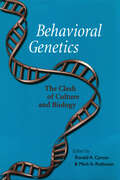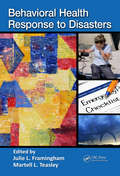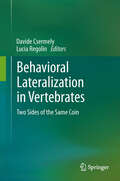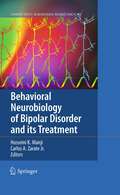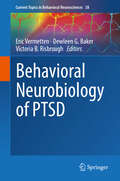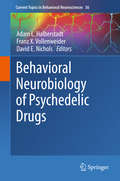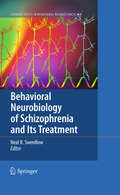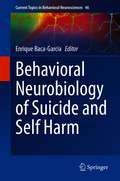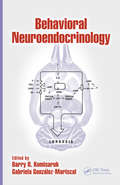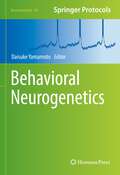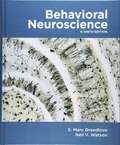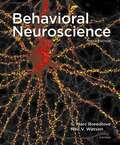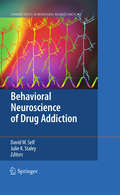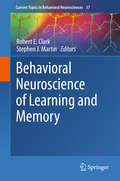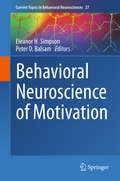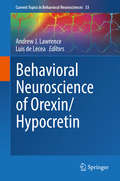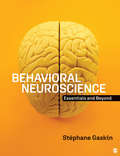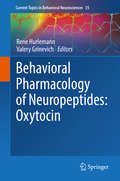- Table View
- List View
Behavioral Genetics of the Mouse Volume II
by Susanna Pietropaolo Wim E. Crusio Frans Sluyter Susanna Pietropaolo Frans SluyterThe second volume of Behavioral Genetics of the Mouse provides a comprehensive overview of the major genetically modified mouse lines used to model human neurobehavioral disorders; from disorders of perception, of autonomous and motor functions to social and cognitive syndromes, drug abuse and dependence as well as neurodegenerative pathologies. Mouse models obtained with different types of genetic manipulations (i.e. transgenic, knockout/in mice) are described in their pathological phenotypes, with a special emphasis on behavioral abnormalities. The major results obtained with many of the existing models are discussed in depth highlighting their strengths and limitations. A lasting reference, the thorough reviews offer an easy entrance into the extensive literature in this field, and will prove invaluable to students and specialists alike.
Behavioral Genetics: The Clash of Culture and Biology
by Ronald A. Carson and Mark A. RothsteinNine essays examining the ethical, cultural, legal, and biological underpinnings of behavioral genetics.Scientists conducting human genome research are identifying genetic disorders and traits at an accelerating rate. Genetic factors in human behavior appear particularly complex and slow to emerge, yet are raising their own set of difficult ethical, legal, and social issues. In Behavioral Genetics: The Clash of Culture and Biology, Ronald Carson and Mark Rothstein bring together well-known experts from the fields of genetics, ethics, neuroscience, psychiatry, sociology, and law to address the cultural, legal, and biological underpinnings of behavioral genetics. The authors discuss a broad range of topics, including the ethical questions arising from gene therapy and screening, molecular research in psychiatry, and the legal ramifications and social consequences of behavioral genetic information. Throughout, they focus on two basic concerns: the quality of the science behind behavioral genetic claims and the need to formulate an appropriate, ethically defensible response when the science turns out to be good.“This book is well written and stimulating. The issues it raises are important for scientists and for those working in the legal and social-services fields, but they clearly also have relevance for everyone.” —The New England Journal of Medicine“This . . . is the best introduction to behavioral genetics that I have read. The varying viewpoints . . . are presented with such clarity that [this book] should appeal to the general public and serve as a basic text for college courses.” —Jay Katz, Elizabeth K. Dollard Professor Emeritus of Law, Medicine, and Psychiatry, Harvey L. Karp Professiorial Lecturer in Law and Psychoanalysis, Yale Law School
Behavioral Health Response to Disasters
by Julie L. Framingham, Martell L. TeasleyDisasters can cause long-term disruptions to the routines of individuals and communities, placing survivors at risk of developing serious mental health and substance abuse problems. Disaster behavioral health services provide emotional support, help normalize stress reactions, assess recovery options, and encourage healthy coping behaviors. They al
Behavioral Health and Human Interactions in Space
by Nick KanasThis textbook covers the range of psychological and interpersonal issues that can affect astronauts living and working in space. It deals with the three major risk areas cited by NASA’s Behavioral Health and Performance Element: Behavioral Medicine, Team Risk, and Sleep Risk. Based on the author’s more than 50 years of experience in space-related activities writing, conducting research, and teaching undergraduate and graduate courses, the book follows a comprehensive range of topics that include: cognitive effects; psychiatric issues; cultural influences; salutogenic and positive aspects of space travel; autonomy and delayed communication; current plans to return to the Moon and Mars; analysis of study environments such as the polar regions, submersible habitats, and space simulation facilities; and more. It draws on research, literature, and case studies from the 1950s onward, showing readers in a natural and accessible way how the field has progressed over time. The book contains ample end-of-chapter summaries and exercises as well as a complete glossary of key terms. As such, it will serve students taking courses in aerospace psychology, psychiatry, sociology, human factors, medicine, and related social sciences, in addition to space industry professionals and others interested in the complexities of people living and working in space.
Behavioral Lateralization in Vertebrates: Two Sides of the Same Coin
by Lucia Regolin Davide CsermelyFunctional lateralization in the human brain was first identified in the classic observations by Broca in the 19th century. Only one hundred years later, however, research on this topic began anew, discovering that humans share brain lateralization not only with other mammals, but with other vertebrates and even invertebrates. Studies on lateralization have also received considerable attention in recent years due to their important evolutionary implications, becoming an important and flourishing field of investigation worldwide among ethnologists and psychologists. The chapters of this book concern the emergence and adaptive function of lateralization in several aspects of behavior for a wide range of vertebrate taxa. These studies span from how lateralization affects some aspects of fitness in fishes, or how it affects the predatory and the exploratory behavior of lizards, to navigation in the homing flights of pigeons, social learning in chicks, the influence of lateralization on the ontogeny process of chicks, and the similarity of manual lateralization (handedness) between humans and apes, our closest relatives.
Behavioral Neurobiology of Aging (Current Topics in Behavioral Neurosciences #10)
by Marie-Christine Pardon Mark W. BondiThis volume discusses the current state of research findings related to healthy brain aging by integrating human clinical studies and translational research in animal models. Several chapters offer a unique overview of successful aging, age-related cognitive decline and its associated structural and functional brain changes, as well as how these changes are influenced by reproductive aging. Insights provided by preclinical studies in mouse models and advanced neuroimaging techniques in humans are also presented.
Behavioral Neurobiology of Bipolar Disorder and its Treatment (Current Topics in Behavioral Neurosciences #5)
by Husseini K. Manji Carlos A. Zarate Jr.This book offers the most up-to-date information about research surrounding the neurobiology of bipolar disorder as well as currently available and novel therapeutic options. The volume has assembled a widely respected group of preclinical and clinical researchers who bring their expertise to bear upon this illness by reviewing cutting-edge research and clinical evidence regarding the pathophysiology and treatment of bipolar disorder. Early chapters review the course and outcome and genetics of this highly heritable condition, including chapters on epigenetics and clinical endophenotypes. Several chapters offer a remarkably thorough and unique overview of the neurobiology of the disorder, including what is known from neuroimaging work and the development of animal models. Finally, the book covers treatment strategies for bipolar disorder, including both traditional and novel therapeutics, as well as non-pharmacological treatments. It offers both researchers and clinicians key insights into this devastating disorder.
Behavioral Neurobiology of PTSD (Current Topics in Behavioral Neurosciences #38)
by Eric Vermetten Dewleen G. Baker Victoria B. RisbroughThis volume focuses on the behavioral neuroscience that supports our understanding of the neurobiology of trauma risk and response. The collection of articles focuses on both preclinical and clinical reviews of (1) state-of-the-art knowledge of mechanisms of posttraumatic stress disorder (PTSD) and co-occurring disorders, (2) the biological and psychological constructs that support risk and resiliency for trauma disorders, and (3), novel treatment strategies and therapeutics on the horizon.
Behavioral Neurobiology of Psychedelic Drugs (Current Topics In Behavioral Neurosciences Ser. #36)
by Adam L. Halberstadt Franz X. Vollenweider David E. NicholsThis volume brings together the latest basic and clinical research examining the effects and underlying mechanisms of psychedelic drugs. Examples of drugs within this group include LSD, psilocybin, and mescaline. Despite their structural differences, these compounds produce remarkably similar experiences in humans and share a common mechanism of action. Commonalities among the substances in this family are addressed both at the clinical and phenomenological level and at the basic neurobiological mechanism level. To the extent possible, contributions relate the clinical and preclinical findings to one another across species. The volume addresses both the risks associated with the use of these drugs and the potential medical benefits that might be associated with these and related compounds.
Behavioral Neurobiology of Schizophrenia and Its Treatment (Current Topics in Behavioral Neurosciences #4)
by Neal R. SwerdlowThis book describes the state-of-the-art of treatment of schizophrenia and reflects its development in 22 chapters written by leading authorities in the field
Behavioral Neurobiology of Suicide and Self Harm (Current Topics in Behavioral Neurosciences #46)
by Enrique Baca-GarciaThis book reviews the recent research into biological aspects of suicide behavior and outlines each of the varied, recent approaches to prevent suicide. Suicidal behavior, perhaps, is the most complex behavior that combines biological, social, and psychological factors. A new frontier and new opportunities are opening with the technologies of data acquisition and data analysis. Personalized models based on digital phenotype could provide promising strategies for preventing suicide.
Behavioral Neuroendocrinology
by Barry R. Komisaruk Gabriela González-MariscalInspired by Carlos Beyer’s 50 years of pioneering research and influence on his students and colleagues, Behavioral Neuroendocrinology builds upon Beyer’s fundamental discoveries and concepts as well as their widespread implications. It presents original research and reviews on mechanisms — genomic and non-genomic — of steroid and protein hormone action; the role of steroid metabolism, especially aromatization, protein phosphorylation, and neurotransmitter action in mediating reproductive behavior and sexual differentiation; and brain and spinal cord mechanisms in sexual behavior and analgesia. This book presents a rich diversity of topics — lactation, maternal behavior, pheromone action, chronobiology, allodynia, angiogenesis, prostate physiology, sexual motivation, and specific brain systems, including vomeronasal system, cerebellum, preoptic area, hypothalamus, and spinal cord. This book brings together, in one source, an international "family" of researchers whose work has evolved in diverse but related ways from a seminal set of discoveries and concepts in behavioral neuroendocrinology.
Behavioral Neurogenetics (Current Topics in Behavioral Neurosciences #12)
by Andreas Reif John F. CryanThis book covers a wide array of topics relevant to behavioral genetics from both a preclinical and clinical standpoint. Indeed in juxtaposing both areas of research the reader will appreciate the true translational nature of the field. Topics covered range from technical advances in genetic analysis in humans and animals to specific descriptions of advances in schizophrenia, attention disorders, depression and anxiety disorders, autism, aggression, neurodegeneration and neurodevelopmental disorders. The importance of gene-environment interactions is emphasised and the role of neuroimaging in unravelling the functional consequences of genetic variability described. This volume will be valued by both the basic scientist and clinician alike who may use it as a detailed reference book. It will also be of use to the novice to the field, to whom it will serve as an in-depth introduction to this exciting area of research.
Behavioral Neurogenetics (Neuromethods #181)
by Daisuke YamamotoThis volume looks at the framework in which different scientific disciplines are integrated into the latest studies in behavioral neurogenetics, and covers new approaches toward understanding the system that controls behavior across the animal kingdom. Chapters in this book cover topics such as mapping brain-wide mesoscale connectome from single animals with BRICseq; gut microbes and Drosophila behavior; bioassaying the function of pheromones in Drosophila melanogaster’s social behavior; automated behavior analysis using a YOLO-based object detection system; and proteomic analysis of C. elegans neurons using TurboID-based proximity labeling. In the Neuromethods series style, chapters include the kind of detail and key advice from the specialists needed to get successful results in your laboratory. Cutting-edge and practical, Behavioral Neurogenetics is a valuable resource for experienced and novice researchers interested in learning more about this field and its future developments.
Behavioral Neuroscience
by S. Marc Breedlove Neil V. WatsonInstructors of behavioral neuroscience are faced with the challenge of how to teach the course's complex material in an accessible and relatable, yet comprehensive way for undergraduate students. For more than twenty years, Breedlove and Watson's Behavioral Neuroscience has successfully solved these problems by presenting the most current, definitive, clear, and authoritative introduction to the field. Using stellar examples of today's most exciting research, an unparalleled art program that clarifies even complex biological processes, visual summaries to remind students of the principle findings presented in each chapter, and a comprehensive suite of digital support tools—including animations with built-in assessments that help test the student's knowledge of biological and behavioral processes and neuroanatomy—Behavioral Neuroscience, Ninth Edition, remains the best resource available to teach introductory neuroscience and behavioral neuroscience courses.
Behavioral Neuroscience
by S. Marc Breedlove Neil WatsonBreedlove & Watson's tenth edition of Behavioral Neuroscience combines the most current and exciting research in the field with an unparalleled art program and a suite of interactive digital tools to help introductory neuroscience and behavioral neuroscience students grasp complex biological processes. For more then twenty years, Breedlove & Watson's Behavioral Neuroscience has successfully presented the most current research through an engaging narrative, strong clinical examples, an exceptional visual approach to the content, and an authoritative introduction to the field. Written for the first course in biopsychology and neuroscience, Behavioral Neuroscience, Tenth Edition, provides a strong foundation for understanding neural functioning and brain-behavior relations. Using stellar examples of today's most exciting research, an unparalleled art program that clarifies complex biological processes, and visual summaries that remind students of the principle findings presented in each chapter, Behavioral Neuroscience helps introductory neuroscience and behavioral neuroscience understand the dynamic and exciting field of neuroscience.
Behavioral Neuroscience (Eighth Edition)
by S. Marc Breedlove Neil V. WatsonFor 20 years, instructors have relied on the textbook Biological Psychology for a definitive and comprehensive survey of the neuroscience of behavior. Thanks to the explosion of work in the neurosciences, each of the seven editions has included more neural details than the one before. Thus the time has come to revise the title to reflect the evolution of both the book and the field: Behavioral Neuroscience. <P> Behavioral Neuroscience, Eighth Edition, provides undergraduates with a lively survey of the field. It offers a broad perspective, encompassing cutting edge neuroscience, lucid descriptions of behavior, evolutionary and developmental perspectives, and clinical applications of research. Despite this comprehensive range of material, the authors have striven in the latest revision to lay bare the neuroscience concepts underlying behavior with concision and clarity.
Behavioral Neuroscience of Drug Addiction (Current Topics in Behavioral Neurosciences #3)
by Julie K. Staley Gottschalk David W. SelfThis volume highlights current state-of-the-art approaches and important findings on the behavioral neurobiology of drug addiction by prominent neuroscientists. Preclinical chapters span synaptic neuroplasticity associated with drug use, the neural systems underlying conditioned drug effects implicated in drug craving, and the role of sensitization and withdrawal processes in addictive behavior. Chapters on human studies emphasize neuroimaging of neurotransmitters and receptors, drug craving and other cognitive abnormalities in human drug abusers. Human studies also describe work on genetic vulnerability and the neuroeconomics of drug addiction, and novel pharmacological approaches to drug abuse treatment.
Behavioral Neuroscience of Learning and Memory (Current Topics In Behavioral Neurosciences Ser. #37)
by Robert E. Clark Stephen J. Martin‘Behavioral Neuroscience of Learning and Memory’ brings together the opinions and expertise of some of the world’s foremost neuroscientists in the field of learning and memory research. The volume provides a broad coverage of contemporary research and thinking in this field, focusing both on well established topics such as the medial temporal lobe memory system, as well as emerging areas of research such as the role of memory in decision making and the mechanisms of perceptual learning. Key intersecting themes include the molecular and cellular mechanisms of memory formation, the multiplicity of memory systems in the brain, and the way in which technological innovation is driving discovery. Unusually for a volume of this kind, this volume brings together research from both humans and animals—often relatively separate areas of discourse—to give a more comprehensive and integrated view of the field. The book will be of interest to both established researchers who wish to broaden their knowledge of topics outside of their specific areas of expertise, and for students who need a resource to help them make sense of the vast scientific literature on this subject.
Behavioral Neuroscience of Motivation (Current Topics in Behavioral Neurosciences #27)
by Eleanor H. Simpson Peter D. BalsamThis volume covers the current status of research in the neurobiology of motivated behaviors in humans and other animals in healthy condition. This includes consideration of the psychological processes that drive motivated behavior and the anatomical, electrophysiological and neurochemical mechanisms which drive these processes and regulate behavioural output. The volume also includes chapters on pathological disturbances in motivation including apathy, or motivational deficit as well as addictions, the pathological misdirection of motivated behavior. As with the chapters on healthy motivational processes, the chapters on disease provide a comprehensive up to date review of the neurobiological abnormalities that underlie motivation, as determined by studies of patient populations as well as animal models of disease. The book closes with a section on recent developments in treatments for motivational disorders.
Behavioral Neuroscience of Orexin/Hypocretin (Current Topics in Behavioral Neurosciences #33)
by Luis De Lecea Andrew J. LawrenceThis issue of Current Topics in Behavioral Neuroscience focuses on the neuropeptide orexin (hypocretin) and brings together scientists from around the world who will provide a timely discussion of how this peptide regulates behavior. This is a fast-moving field, and with the incorporation of novel technologies, new breakthroughs are likely to continue. For example, the use of optogenetic approaches has enabled the identification of the role of orexin-containing neurons in arousal states, critical for higher order functioning. From a clinical perspective, genetic polymorphisms in hypocretin/orexin and orexin receptors are implicated in a number of psychiatric disorders. In addition, advanced clinical trials are currently underway for orexin receptor antagonists in the treatment of insomnia and sleep disorders. We aim to capture a broad audience of basic scientists and clinicians.
Behavioral Neuroscience: Essentials and Beyond
by Stéphane GaskinBehavioral Neuroscience: Essentials and Beyond shows students the basics of biological psychology using a modern and research-based perspective. With fresh coverage of applied topics and complex phenomena, including social neuroscience and consciousness, author Stéphane Gaskin delivers the most current research and developments surrounding the brain′s functions through student-centered pedagogy. Carefully crafted features introduce students to challenging biological and neuroscience-based concepts through illustrations of real-life application, exploring myths and misconceptions, and addressing students′ assumptions head on.
Behavioral Neuroscience: Essentials and Beyond
by Stéphane GaskinBehavioral Neuroscience: Essentials and Beyond shows students the basics of biological psychology using a modern and research-based perspective. With fresh coverage of applied topics and complex phenomena, including social neuroscience and consciousness, author Stéphane Gaskin delivers the most current research and developments surrounding the brain′s functions through student-centered pedagogy. Carefully crafted features introduce students to challenging biological and neuroscience-based concepts through illustrations of real-life application, exploring myths and misconceptions, and addressing students′ assumptions head on.
Behavioral Pharmacology of Neuropeptides: Oxytocin (Current Topics in Behavioral Neurosciences #35)
by Rene Hurlemann Valery GrinevichThis volume collects cutting-edge expert reviews in the oxytocin field and will be of interest to a broad scientific audience ranging from social neuroscience to clinical psychiatry. The role of the neuropeptide oxytocin in social behaviors is one of the earliest and most significant discoveries in social neuroscience. Influential studies in animal models have delineated many of the neural circuits and genetic components that underlie these behaviors. These discoveries have inspired researchers to investigate the effects of oxytocin on brain and behavior in humans and its potential relevance as a treatment for psychiatric disorders including borderline personality disorder and autism and schizophrenia spectrum disorders. In fact, there is no established social psychopharmacology in Psychiatry, and oxytocin can be seen as the first endogenous agent specifically addressing social-cognitive impairment in psychiatric disorders, with animal research suggesting that it could be especially efficient in the early postnatal period. From a human perspective, it is crucial to understand more precisely who can benefit from potential oxytocin-related treatments, which outcome measures will best represent their effects, how they should be administered, and what brain mechanisms are likely involved in mediating their effects. This type of “precision medicine” approach is in line with the research domain criteria defined by the U.S. National Institute of Mental Health.
Behaviors of Trace Metals in Environment: The Pollution in Regional and Metropolis Areas
by Hui ZhangThis book focuses on the behavior and impact of trace metals in the environment by studying typical cases from China such as the Hetao Area of the Yellow River, Shanghai, and Nanjing. Based on samples and experiments on the behavior of pollutants, it systematically discusses the regulation of trace metals’ distribution, accumulation, and migration, associated with the cause of formation demonstration. The author subsequently uses the acquired data to review the evolving trend of trace metal behaviors in natural systems (river or lake water, sediments, and soils), develops suggestions for the prevention of their negative effects, and devise treatments. Moreover, he proposes solutions to difficult research issues such as trace metal speciation extraction, and an analysis, along with operational procedures. Given its scope, the book will provide a valuable guide for researchers and engineers in relevant disciplines of the environmental sciences and engineering, and for environmental policymakers to consult in practices.

